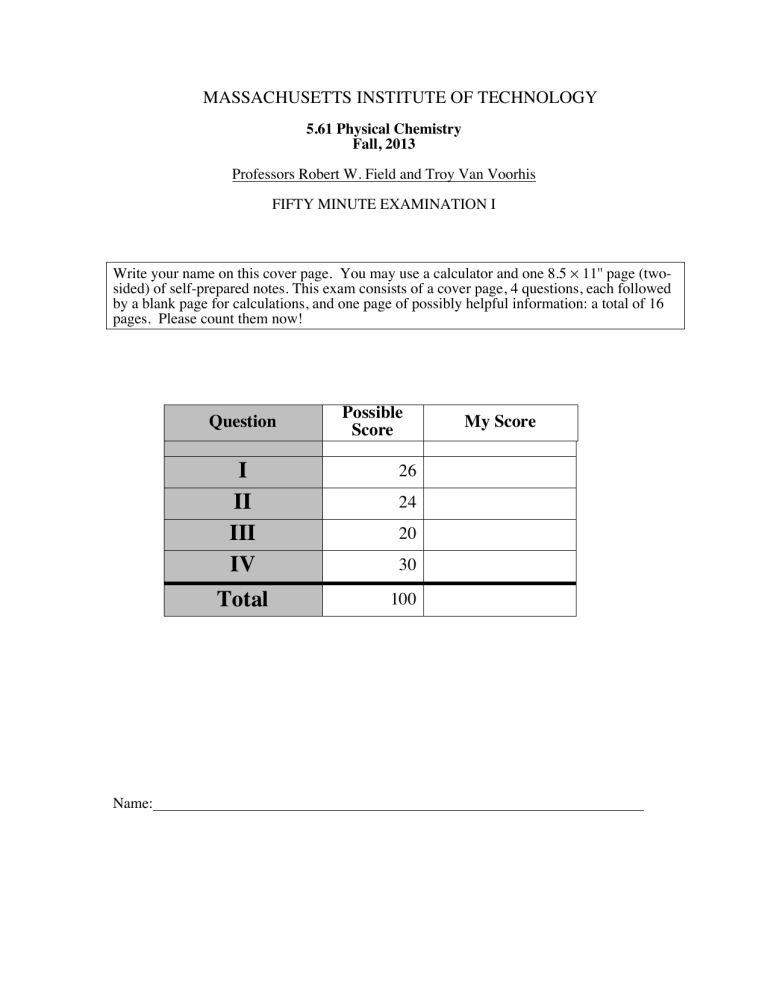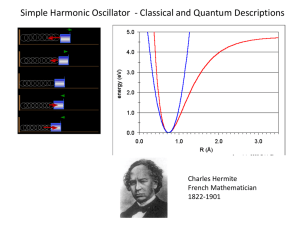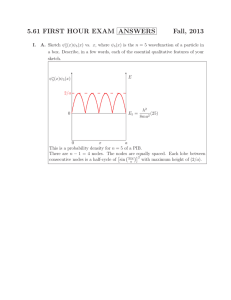MASSACHUSETTS INSTITUTE OF TECHNOLOGY
advertisement

MASSACHUSETTS INSTITUTE OF TECHNOLOGY
5.61 Physical Chemistry
Fall, 2013
Professors Robert W. Field and Troy Van Voorhis
FIFTY MINUTE EXAMINATION I
Write your name on this cover page. You may use a calculator and one 8.5 × 11'' page (twosided) of self-prepared notes. This exam consists of a cover page, 4 questions, each followed
by a blank page for calculations, and one page of possibly helpful information: a total of 16
pages. Please count them now!
Question
Name:
Possible
Score
I
II
III
IV
26
Total
100
24
20
30
My Score
.
..
...
..
...
Fall, 2013 ..
..
...
..
... ` = 0
....
..
ψ 5* (x)ψ 5 (x) vs. x, where
... ψ5(x)
5.61 Exam I
I.
as function of n, `
Page 1 of 15 pages 2
r± = a0 n
Short Answer
(26 points)
A. (5 points)
Sketch
is the n = 5 wavefunction of
?
a particle in a box. Describe, in a few words, each of the essential
qualitative features of your sketch.
?
5 (x) 5 (x)
6
6
E
h2
E5 =
(25)
8ma2
0
0
B. (5 points)
?
5 (x) 5 (x)
0
x
a
Sketch ψ (x)ψ 5 (x) vs. x, where ψ5(x) is the v = 5 wavefunction of
a harmonic oscillator. Describe, in a few words, each of the
essential qualitative features of this sketch.
*
5
6
...
.
...
...
...
...
...
...
.
.
...
..
...
..
...
...
...
...
.
...
.
..
...
5
...
...
..
...
...
.
...
.
..
...
.
..
...
...
...
...
...
..
.
...
.
...
...
...
...
...
...
...
..
.
...
...
...
...
...
..
...
...
.
...
...
...
...
...
..
...
..
.
.
...
...
...
...
...
..
...
...
...
.
.
....
....
....
...
....
...
....
....
.
....
.
.
......
....
......
.....
........
......
...........
.......
.................................
E = }!(5.5)
0
x
1± 1
`(
5.61 Exam I
Fall, 2013
Page 2 of 15 pages
(i) (3 points) Sketch ψ1(x) and ψ2(x) for a particle in a box where
there is a small and thin barrier in the middle of the
box, as shown on this V(x):
C.
6
6
V (x)
✓
-
0
h2
8ma2
◆
a/100
a/2
a
(ii) (2 points) Make a very approximate estimate of E2 – E1 for this
PIB with a thin barrier in the middle. Specify
whether E2 – E1 is smaller than or larger than
⎛ h2 ⎞
, which is the energy level spacing
3⎜
⎝ 8ma 2 ⎟⎠
between the n = 2 and n = 1 energy levels of a PIB
without a barrier in the middle.
10
5.61 Exam I
Fall, 2013
Page 3 of 15 pages
1 2
kx for
2
x < 0 and V(x) = ∞ for x ≥ 0. The energy levels of a full harmonic
oscillator are
Consider the half harmonic oscillator, which has V (x) =
D. (5 points)
E(v) = ω(v + 1/2)
where ω = [k/µ]1/2. Sketch the v = 0 and v = 1 ψv(x) of the half
harmonic oscillator and say as much as you can about a general
energy level formula for the half harmonic oscillator. A little
speculation might be a good idea.
V (x)
6
...
..
..
..
..
..
..
..
..
..
..
..
..
...
..
..
..
..
..
..
...
...
...
...
...
...
...
...
..
...
...
...
...
...
...
...
...
...
...
...
...
...
...
...
...
...
...
....
....
....
....
....
....
.....
......
......
......
......
......
.......
.......
.......
.........
........
..........
..........
............
...........
.................
....................
.....................................................................................
.
6
v=1
v=0
0
1 (x)
0 (x)
x
5.61 Exam I
E. (6 points)
Fall, 2013
Page 4 of 15 pages
Give exact energy level formulas (expressed in terms of k and µ)
for a harmonic oscillator with reduced mass, µ, where
1
(i) V (x) = kx 2 + V0
2
(ii) V (x) =
1
2
k ( x − x0 )
2
(iii) V (x) =
1 2
k′x where k′ = 4k
2
5.61 Exam I
(Blank page for Calculations)
Fall, 2013
Page 5 of 15 pages
5.61 Exam I
II.
Fall, 2013
PROMISE KEPT: FREE PARTICLE
Page 6 of 15 pages
(24 points)
2 ∂2
+ V0
2m ∂x 2
ψ(x) = aeikx + be−ikx
Ĥ = −
A. (4 points)
Is ψ(x) an eigenfunction of Ĥ ? If so, what is the eigenvalue of
Ĥ , expressed in terms of , m, V0, and k?
B. (4 points)
Is ψ(x) an eigenfunction of p̂ ? Your answer must include an
evaluation of p̂ψ(x) .
C. (4 points)
Write a complete expression for the expectation value of p̂ ,
without evaluating any of the integrals present in p̂ .
5.61 Exam I
D. (4 points)
Fall, 2013
Page 7 of 15 pages
Taking advantage of the fact that
∫
∞
−∞
dxeicx = 0
compute p̂ , the expectation value of p̂ .
E. (4 points)
Suppose you perform a “click-click” experiment on this ψ(x)
where a = –0.632 and b = 0.775. One particle detector is located at
x = +∞ and another is located at x = –∞. Let’s say you do 100
experiments. What would be the fraction of detection events at the
x = +∞ detector?
F. (4 points)
What is the expectation value of Ĥ ?
5.61 Exam I
(Blank page for Calculations)
Fall, 2013
Page 8 of 15 pages
5.61 Exam I
III.
Fall, 2013
Page 9 of 15 pages
â AND ↠FOR HARMONIC OSCILLATOR
(20 points)
âψ v = v1/2 ψ v−1
â †ψ v = ( v + 1) ψ v+1
1/2
N̂ψ v = vψ v
A. (5 points)
B. (15 points)
where N̂ = â †â
†
Show that ⎡â
⎣ ,â⎤⎦ = −1 by applying this commutator to ψv.
Evaluate the following expressions (it is not necessary to explicitly
multiply out all of the factors of v).
(i)
( â ) ( â )
(ii)
( â )5 ( a† )
† 2
5
ψ3
2
ψ3
( )
3
(iii) ∫ dxψ 3 a † ψ 0
(iv) What is the selection rule for non-zero integrals of the
( ) ( â ) ( â )
following operator product a †
(v)
( â + â )
† 2
2
5
† 4
?
= â 2 + ââ † + â †â + â †2 . Simplify using ⎣⎡â † ,â ⎦⎤ = −1 to
yield an expression containing â 2 + â †2 + terms that involve
= â †a and a constant.
N
5.61 Exam I
(Blank page for Calculations)
Fall, 2013
Page 10 of 15 pages
5.61 Exam I
IV.
Fall, 2013
Page 11 of 15 pages
TIME-DEPENDENT WAVE EQUATION AND PIB SUPERPOSITION
(30 POINTS)
For the harmonic oscillator
⎛ ⎞
x̂ = ⎜
⎝ 2 µω ⎟⎠
⎛ µω ⎞
p̂ = ⎜
⎝ 2 ⎟⎠
= â †â
N
1/2
( â
1/2
†
+ â
(
)
i aˆ † − â
)
δ ij = ∫ dxψ *i (x)ψ j , which means orthonormal {ψ n }
ψ (x) = E ψ
H
n
n n
En = ω ( n + 12 )
eigenvalues { En }
Consider the time-dependent state
Ψ ( x,t ) = 2 −1/2 ⎡⎣ e−iE0t ψ 0 (x) + e−iE1t ψ 1 (x) ⎤⎦
= 2 −1/2 e−iE0t ⎣⎡ ψ 0 (x) + e−iω t ψ 1 ⎤⎦
A. (4 points)
Sketch Ψ(x,0) and Ψ(x,t = ωπ ) .
...
..
...
...
...
..
...
...
..
...
.
.
...
.
...
...
...
...
...
..
...
...
...
...
.
.
...
...
...
...
...
..
...
...
...
...
...
.
.
...
...
...
...
...
..
...
...
...
...
...
.
.
...
...
...
...
...
..
...
...
...
..
.
...
.
....
..
....
....
...
....
....
...
....
....
....
....
.
.
....
.
....
....
....
....
....
....
.....
....
......
......
.......
......
.
.
.
.......
.
.
........
......
..........
........
...............
..........
..................................
(x, 0)
...
..
...
...
...
..
...
...
..
...
.
.
...
.
...
...
...
...
...
..
...
...
...
...
.
.
...
...
...
...
...
..
...
...
...
...
...
.
.
...
...
...
...
...
..
...
...
...
...
...
.
.
...
...
...
...
...
..
...
...
...
..
.
...
.
....
..
....
....
...
....
....
...
....
....
...
....
.
....
.
.
....
....
....
....
....
....
.....
....
......
......
......
......
.
.
.......
.
.
.
........
.....
..........
........
..............
.........
......................................
x, !⇡
5.61 Exam I
Fall, 2013
Page 12 of 15 pages
B. (5 points)
Compute ∫ dxΨ * (x,t)N̂Ψ(x,t) .
C. (5 points)
= ∫ dxΨ * (x,t)H
Ψ(x,t) and comment on the
Compute H
.
relationship of N̂ to H
D. (4 points)
Compute x̂ = ∫ dxΨ * (x,t)x̂Ψ(x,t) .
E. (4 points)
Compute x̂ 2 .
THIS PROBLEM IS CANCELLED, BUT YOU NEED TO USE THE ANSWER
FOR THIS QUESTION IN PARTS F AND G. THE ANSWER IS:
x̂ 2 = / µω
5.61 Exam I
Fall, 2013
Page 13 of 15 pages
F. (4 points)
Based on your answer to part E, evaluate V (x) .
G. (4 points)
Based on your answer to parts C and F, evaluate T .
5.61 Exam I
(Blank page for Calculations)
Fall, 2013
Page 14 of 15 pages
5.61 Exam I
Fall, 2013
Some Possibly Useful Definite Integrals and Constants
∫
∞
0
∫
0
∫
0
∞
∞
e−ax dx =
2
1
1/2
[π a]
2
xe− ax dx =
2
1
2a
x 2 e−ax dx =
2
1 1/2 −3/2
π a
4
h = 6.63 × 10–34 J · s
= 1.054 × 10–34 J · s
c = 3.00 × 108 m/s
me = 9.11 × 10–31 kg
mH = 1.67 × 10–27 kg
NA = 6.022 × 1023 mole–1
∫
2π/a
0
sin 2 ax dx =
1
2
Page 15 of 15 pages
MIT OpenCourseWare
http://ocw.mit.edu
5.61 Physical Chemistry
Fall 2013
For information about citing these materials or our Terms of Use, visit: http://ocw.mit.edu/terms.









